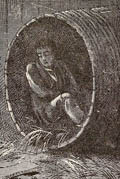|
A pass it is not: it has none of the features of Thermopylæ or the Gorge of Killiecrankie; of the European St. Bernard or Simplon; of the Alleghany Passes or of the Mexican Barrancas. It is not, as it sounds, a ghaut between lofty mountains, or, as the traveler may expect, a giant gateway, opening through Cyclopean walls of beetling rocks that rise in forbidding grandeur as he passes onward to the Western continent. And yet the word "Pass" has its significancy. In that New World where Nature has worked upon the largest scale, where every feature of scenery, river and lake, swamp and forest, prairie and mountain, dwarf their congeners in the old hemisphere, this majestic level-topped bluff, the highest steppe of the continent, upon whose iron surface there is space enough for the armies of the globe to march over, is the grandest and the most appropriate of avenues. A water-shed is always exciting to the traveler. What shall I say of this, where, on the topmost point of American travel, you drink within a hundred yards of the waters of the Atlantic and the Pacific Oceans--that divides the "doorways of the west wind" from the "portals of the sunrise"? On the other side of yon throne of storms, within sight, did not the Sierra interpose, lie separated by a trivial space the fountain-heads that give birth to the noblest rivers of the continent, the Columbia, the Colorado, and the Yellow Stone, which is to the Missouri what the Missouri is to the Mississippi, whence the waters trend to four opposite directions: the Wind River to the northeast; to the southeast the Sweetwater and the Platte; the various branches of the Snake River to the northeast; and to the southwest the Green River, that finds its way into the Californian Gulf.* It is a suggestive spot, this "divortia aquarum": it compels Memory to revive past scenes before plunging into the mysterious "Lands of the Hereafter," which lie before and beneath the feet. The Great Ferry, which steam has now bridged, the palisaded banks of the Hudson, the soft and sunny scenery of the Ohio, and the kingly course of the Upper Mississippi, the terrible beauty of Niagara, and the marvels of that chain of inland seas which winds its water way from Ontario to Superior; the rich pasture-lands of the North, the plantations of the semi-tropical South, and the broad cornfields of the West; finally, the vast meadow-land and the gloomy desert-waste of sage and saleratus, of clay and mauvaise terre, of red butte and tawny rock, all pass before the mind in rapid array ere they are thrust into oblivion by the excitement of a new departure. But we have not yet reached our destination, which is two miles below the South Pass. Pacific Springs is our station; it lies a little down the hill, and we can sight it from the road. The springs are a pond of pure, hard, and very cold water, surrounded by a strip of shaking bog, which must be boarded over before it will bear a man. The hut would be a right melancholy abode were it not for the wooded ground on one hand, and the glorious snow-peaks on the other side of the "Pass." We reached Pacific Springs at 3 P.M., and dined without delay, the material being bouilli and potatoes--unusual luxuries. About an hour afterward the west wind, here almost invariable, brought up a shower of rain, and swept a vast veil over the forms of the Wind-River Mountains. Toward sunset it cleared away, and the departing luminary poured a flood of gold upon the majestic pile--; I have seldom seen a view more beautiful. From the south, the barren rolling table-land that forms the Pass trends northward till it sinks apparently below a ridge of offsets from the main body, black with timber--cedar, cypress, fir, and balsam pine. The hand of Nature has marked, as though by line and level, the place where vegetation shall go and no farther. Below the waist the mountains are robed in evergreens; above it, to the shoulders, they would be entirely bare but for the atmosphere, which has thrown a thin veil of light blue over their tawny gray, while their majestic heads are covered with ice and snow, or are hidden from sight by thunder-cloud or the morning mist. From the south, on clear days, the cold and glittering radiance may be seen at a distance of a hundred miles. The monarch of these mountains is "Frémont's Peak"; its height is laid down at 13, 570 feet above sea level; and second to it is a hoary cone called by the station-people Snowy Peak. |
